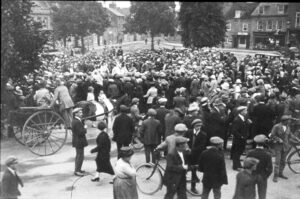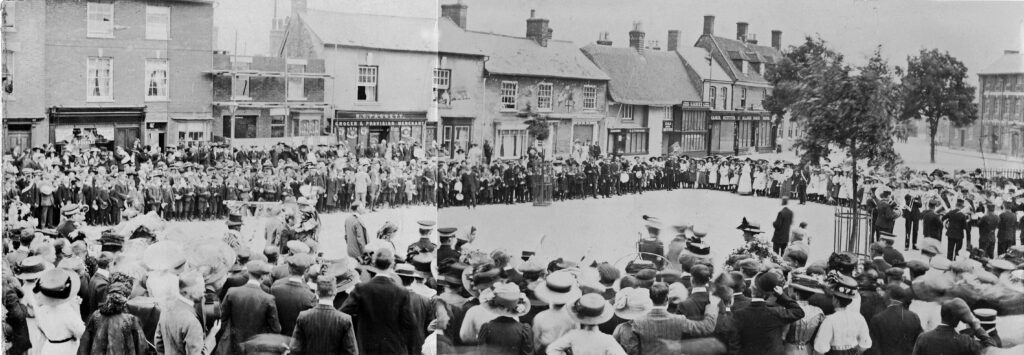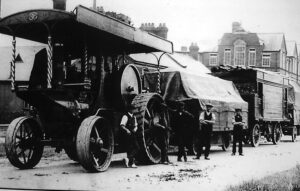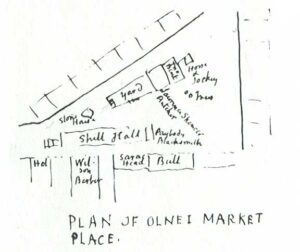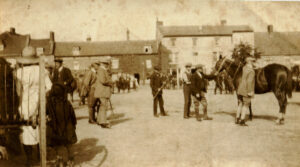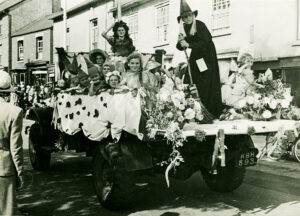Click the ‘Welcome’ heading to start the trail.
This audio trail presents a ‘light’ introduction to the history of Olney Market Place and mainly covers the period from around 1800 to ‘more recent times’. It is divided into three sections addressing the Market Place and a further seven sections covering a selection of the surrounding buildings and their residents.
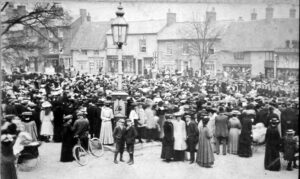
Note the Town Pump with the Lamp mounted on it.
This audio trail presents a ‘light’ introduction to the history of Olney Market Place and mainly covers the period from around 1800 to ‘more recent times’. It is divided into three sections addressing the Market Place and a further seven sections covering a selection of the surrounding buildings and their residents.
If you do choose the ‘live’ visit option using your smartphone, please allow around 30 to 45 minutes for this purpose. You may find it an advantage to have a pair of earphones about your person to deal with any occasional excessive traffic noise from the main road!
As no phone ‘data usage’ costings have not undertaken it would be advisable if you are on a ‘pay as you go’ tariff to check your spend periodically.
Although this trail can be viewed without even venturing out of your home, we would suggest that a ‘live’ visit to Olney Market Place will provide an enhanced experience.
Please note that this trail is not strictly a walking trail, since it only requires the user to move a few metres occasionally to reposition themselves on the Market Place such that they have an adequate view of the subject or section being addressed. Consequently this trail could be considered as ideal for people with limited mobilility, or of course those who would simply like to be entertained whilst sitting on one of the public benches strategically placed around the Market Place!
The start to each section is highlighted as a ‘Bold Title’. Simply click a ‘Bold Title’ to reveal the text and images for that section. (Click the ‘Bold Title’ again to hide the text and images for that section.)
Next, click the audio bar for the voiceover and click a second time to mute it.
Click any image for an enlarged view.
.
.
The Market Place – the reason for Olney’s status as a town – has always been the hub and centre of its life. Olney does not have a Market Charter, instead it has a ‘prescriptive’ market, one founded on ancient custom and viewed as an authoritative claim established by long use. A weekly market has been held on this Market Place since at least 1206 and two fairs held annually, the Cherry Fair in June and the Statute Fair in October.
The Cherry Fair coincided with the Church’s Patronal Festival. Holy Days and were the only ‘holidays’ workers had, so a licence was granted to the Lord of the Manor in 1316 to hold a Cherry Fair ‘for the vigil, feast and morrow of St. Peter and St. Paul’. It was designated a ‘Cherry Fair’ so that the fruit from the many orchards around medieval Olney could be sold off quickly. The Fair was originally held on the Market Place and later when it had primarily developed into a funfair it moved to the ‘Fair Field’ off East Street, now a residential street named Fairfield Close.
Incidentally the bi-annual funfairs returned to the Market place after WW2, but some years later again moved to East Street and sited on ‘Olney’s Football Ground’ formally known as the ‘Nursery field’ or ‘Recreation Ground’.
The Statute Fair in October was probably the usual autumn hiring fair held in country districts when workers could put themselves up for hire. Prospective employers, each distinguished by a badge of office worn in his cap, came to view the various workers either on the Market Place or at an Inn, such as the Bull.
Moving forward a few centuries to the 18th century, the Kettering and Wellingborough to London Turnpike road ran along the western side of the Market Place while the southern side was known as ‘The Parade’.
The sketch dated 1860 is attributed to Walter Pennington Storer a local schoolmaster. This sketch appears to be the only visual evidence of a row of ‘untidy commercial buildings’ which ran from the Round House or Lock Up (Stone House on the sketch) to opposite the ‘poet’s house’ (Orchardside) on the eastern side of the Market Place. The buildings included a yard belonging to Lawrence Spencer, a butcher, also a pub (the Horse and Jockey) belonging to John Bent. On the southern side of Sheil Hall a Mr Paybody was operating a blacksmith’s forge. The annotations at the bottom of the sketch referring to the buildings on the west side of the Market Place are believed to be Hollingsheads, Wilson the barber, The Saracen’s Head and the Bull Hotel.
A well known Market Place image of that period has been added to assist the identification of the buildings on the sketch.
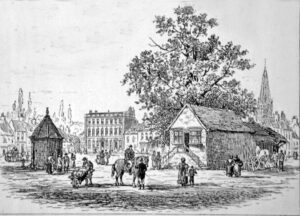
It is possible of course that some of those untidy commercial buildings might have been removed from the Market Place before 1860. Obviously all the ‘commercial buildings’ were eventually removed. Or perhaps, dare one suggest, that the sketch was a W P Storer hoax!?
Olney’s market was held each Monday, but during the second half of the 19th century it fell into decline. Later the market was held fortnightly on Thursdays, and the Cattle Market revived and held again on Mondays. The general market today is still held on Thursdays, but the last cattle market was held in April 1987 and the last Fat Stock Show took place in 1986.
Originally the Lord of the Manor received the rents from the Market, but when part of Olney Court Estate was sold in 1941, Lot 6, entitled ‘Manorial Rights of Fair and Market belonging to the Manor of Olney’ was acquired by the then Olney Parish Council.
Concerts and meetings continued, and still continue to some degree, to be held on the Market Place, being the traditional gathering place and focus for Olney townsfolk. The 1949 British Legion Fete parade and subsequent parades, including the later very popular annual Floral Fiesta parades, incorporated the Market Place into their town tour.
In the 1940s, Tom Garner, a successful draper trading and residing on the eastern side of the Market Place, left a thousand pounds in his will towards the resurfacing of the Market Place, which was completed in the early 1960’s. This improvement was the salvation of the modern market, resurrecting it from two stalls to, often, a full list of traders pitching a stall on Olney’s Thursday Market.
Today, the Thursday Market remains well attended and relatively stable in terms of the number of stalls and the variety of produce and goods available. In addition, a Sunday Farmer’s Market held on the first Sunday in each month, also appears to be stable and doing brisk business.
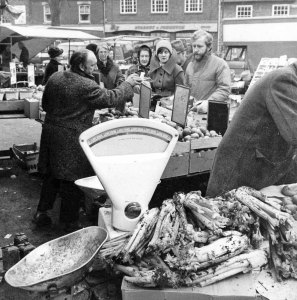
Also it needs to be acknowledged that the Market Place currently fulfils the important role of a very convenient, but somewhat inadequate, car park for most of the week and it is difficult to envisage a time when it will be able to relinquish this role.
